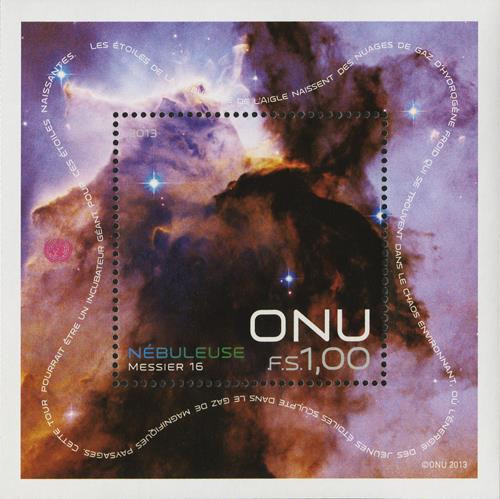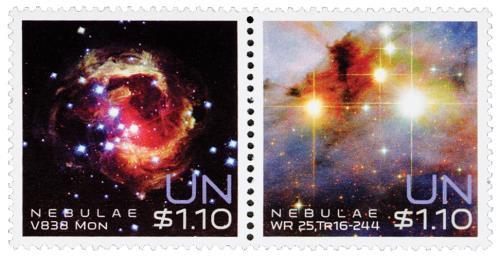
# UNG567-68 - 2013 1.40fr UN Geneva Space
2013 Space
Geneva Office
The 2013 U.N. Space stamps celebrate the largest space event in the world, World Space Week, celebrated each year from October 4th to the 10th. World Space Week seeks to promote sustainable economic development and to excite, encourage and inspire, through international space education. This year’s stamps feature varied nebulae, enormous clouds of dust particles and gas in space.
The term “nebula” comes from the Latin word for cloud. The space clouds we identify as nebulae are often regions where stars are being formed or regions left by dead or dying stars. Nebula clouds can range vastly in shape and size.
Nebulae NGC 2346 and Sh 2-106 are pictured on the 1,40 Swiss franc stamps. NGC 2346, known as a butterfly nebula, contains a pair of stars rapidly orbiting each other at its center. The stars’ relationship with each other is what causes the nebula’s gas and particles to take on the butterfly shape. The giant star-forming region designated as Sh 2-106 is a nebula in the constellation Cygnus, 3,300 light years from earth. Within the cloud is a young star in its final stage of formation. Material is violently released from the star, disturbing the surrounding gas and dust, causing the nebula’s hourglass shape.
2013 Space
Geneva Office
The 2013 U.N. Space stamps celebrate the largest space event in the world, World Space Week, celebrated each year from October 4th to the 10th. World Space Week seeks to promote sustainable economic development and to excite, encourage and inspire, through international space education. This year’s stamps feature varied nebulae, enormous clouds of dust particles and gas in space.
The term “nebula” comes from the Latin word for cloud. The space clouds we identify as nebulae are often regions where stars are being formed or regions left by dead or dying stars. Nebula clouds can range vastly in shape and size.
Nebulae NGC 2346 and Sh 2-106 are pictured on the 1,40 Swiss franc stamps. NGC 2346, known as a butterfly nebula, contains a pair of stars rapidly orbiting each other at its center. The stars’ relationship with each other is what causes the nebula’s gas and particles to take on the butterfly shape. The giant star-forming region designated as Sh 2-106 is a nebula in the constellation Cygnus, 3,300 light years from earth. Within the cloud is a young star in its final stage of formation. Material is violently released from the star, disturbing the surrounding gas and dust, causing the nebula’s hourglass shape.











